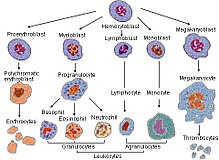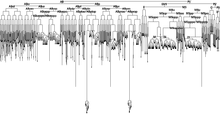Cell lineage



The cell lineage refers to the history of development of a cell in a tissue or organ of the embryo to. Thereby differentiating embryonic stem cells into specialized cells. The graphical representation of the cell lineage is called the cell lineage.
properties
The respective cell lineage arises from spatiotemporal gene expression . Eutele organisms have a fixed number and developmental steps of cells, e.g. B. in the nematode Caenorhabditis elegans (1031 in the male nematode or after apoptosis 959 cells in the hermaphroditic nematode). For the complete description of the cell lineage of C. elegans , John Sulston received the 2002 Nobel Prize in Physiology or Medicine .
People
In humans, at least 210 cell types can arise from a fertilized egg cell or a totipotent stem cell . The number of cells per cell type is individually variable.
Methods
The cell lineage can e.g. B. can be determined by a clonal analysis or by microscopic observation, sometimes also in connection with an immunostaining or as a single cell analysis . By confocal microscopy tissue can be examined with a bit more thickness.
history
From 1870, the pattern of cell division and the specialization of cells in nematodes and ascidia were first described by Charles Otis Whitman . He observed that in these organisms the pattern and specialization are individually invariable. In other organisms, the number of cells and their development are not so fixed, presumably due to external influences.
Web links
Individual evidence
- ↑ Collins English Dictionary - Complete & Unabridged 10th Edition. . HarperCollins Publishers., (Retrieved June 2, 2014).
- ^ JE Sulston, HR Horvitz: Post-embryonic cell lineages of the nematode, Caenorhabditis elegans . In: Developmental Biology . 56, No. 1, 1977, pp. 110-56. doi : 10.1016 / 0012-1606 (77) 90158-0 . PMID 838129 .
- ↑ J. Kimble, D. Hirsh: The postembryonic cell lineages of the hermaphrodite and male gonads in Caenorhabditis elegans . In: Developmental Biology . 70, No. 2, 1979, pp. 396-417. doi : 10.1016 / 0012-1606 (79) 90035-6 . PMID 478167 .
- ^ F. Amat, PJ Keller: Towards comprehensive cell lineage reconstructions in complex organisms using light-sheet microscopy. In: Development, growth & differentiation. Volume 55, number 4, May 2013, ISSN 1440-169X , pp. 563-578, doi : 10.1111 / dgd.12063 , PMID 23621671 .
- ^ TM Gibson, CA Gersbach: The role of single-cell analyzes in understanding cell lineage commitment. In: Biotechnology journal. Volume 8, number 4, April 2013, ISSN 1860-7314 , pp. 397-407, doi : 10.1002 / biot.201200201 , PMID 23520130 , PMC 3753774 (free full text).
- ↑ a b c A.D. Chisholm: Cell Lineage Archived from the original on April 9, 2011. Info: The archive link was automatically inserted and not yet checked. Please check the original and archive link according to the instructions and then remove this notice. In: Encyclopedia of Genetics . 2001, pp. 302-310. doi : 10.1006 / rwgn.2001.0172 . Retrieved June 2, 2014.
- ^ Charles Galperin: From Cell Lineage to Developmental Genetics. In: History and Philosophy of the Life Sciences. 20, No. 3, 1998, pp. 301-350.
